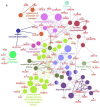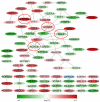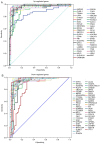Bioinformatics analysis to screen key genes in papillary thyroid carcinoma
- PMID: 31897130
- PMCID: PMC6924100
- DOI: 10.3892/ol.2019.11100
Bioinformatics analysis to screen key genes in papillary thyroid carcinoma
Abstract
Papillary thyroid carcinoma (PTC) is the most common type of thyroid carcinoma, and its incidence has been on the increase in recent years. However, the molecular mechanism of PTC is unclear and misdiagnosis remains a major issue. Therefore, the present study aimed to investigate this mechanism, and to identify key prognostic biomarkers. Integrated analysis was used to explore differentially expressed genes (DEGs) between PTC and healthy thyroid tissue. To investigate the functions and pathways associated with DEGs, Gene Ontology, pathway and protein-protein interaction (PPI) network analyses were performed. The predictive accuracy of DEGs was evaluated using the receiver operating characteristic (ROC) curve. Based on the four microarray datasets obtained from the Gene Expression Omnibus database, namely GSE33630, GSE27155, GSE3467 and GSE3678, a total of 153 DEGs were identified, including 66 upregulated and 87 downregulated DEGs in PTC compared with controls. These DEGs were significantly enriched in cancer-related pathways and the phosphoinositide 3-kinase-AKT signaling pathway. PPI network analysis screened out key genes, including acetyl-CoA carboxylase beta, cyclin D1, BCL2, and serpin peptidase inhibitor clade A member 1, which may serve important roles in PTC pathogenesis. ROC analysis revealed that these DEGs had excellent predictive performance, thus verifying their potential for clinical diagnosis. Taken together, the findings of the present study suggest that these genes and related pathways are involved in key events of PTC progression and facilitate the identification of prognostic biomarkers.
Keywords: integrated analysis; key genes; microarray; papillary thyroid carcinoma.
Copyright: © Liu et al.
Figures







Similar articles
-
BCL2 and hsa-miR-181a-5p are potential biomarkers associated with papillary thyroid cancer based on bioinformatics analysis.World J Surg Oncol. 2019 Dec 16;17(1):221. doi: 10.1186/s12957-019-1755-9. World J Surg Oncol. 2019. PMID: 31842912 Free PMC article.
-
Key genes and pathways predicted in papillary thyroid carcinoma based on bioinformatics analysis.J Endocrinol Invest. 2016 Nov;39(11):1285-1293. doi: 10.1007/s40618-016-0491-z. Epub 2016 Jun 1. J Endocrinol Invest. 2016. PMID: 27250077
-
Identification of differentially expressed genes and signaling pathways in papillary thyroid cancer: a study based on integrated microarray and bioinformatics analysis.Gland Surg. 2021 Feb;10(2):629-644. doi: 10.21037/gs-20-673. Gland Surg. 2021. PMID: 33708546 Free PMC article.
-
Identification of potential biomarkers and drugs for papillary thyroid cancer based on gene expression profile analysis.Mol Med Rep. 2016 Dec;14(6):5041-5048. doi: 10.3892/mmr.2016.5855. Epub 2016 Oct 19. Mol Med Rep. 2016. PMID: 27779685 Free PMC article.
-
Identification of key genes of papillary thyroid cancer using integrated bioinformatics analysis.J Endocrinol Invest. 2018 Oct;41(10):1237-1245. doi: 10.1007/s40618-018-0859-3. Epub 2018 Mar 8. J Endocrinol Invest. 2018. PMID: 29520684
Cited by
-
ACC2 is under-expressed in lung adenocarcinoma and predicts poor clinical outcomes.J Cancer Res Clin Oncol. 2022 Nov;148(11):3145-3162. doi: 10.1007/s00432-021-03910-1. Epub 2022 Jan 22. J Cancer Res Clin Oncol. 2022. PMID: 35066671 Free PMC article.
-
Histone acetylation modifications: A potential targets for the diagnosis and treatment of papillary thyroid cancer.Front Oncol. 2022 Nov 29;12:1053618. doi: 10.3389/fonc.2022.1053618. eCollection 2022. Front Oncol. 2022. PMID: 36523971 Free PMC article. Review.
-
Exploration of the Potential Biomarkers of Papillary Thyroid Cancer (PTC) Based on RT2 Profiler PCR Arrays and Bioinformatics Analysis.Cancer Manag Res. 2020 Sep 28;12:9235-9246. doi: 10.2147/CMAR.S266473. eCollection 2020. Cancer Manag Res. 2020. PMID: 33061614 Free PMC article.
-
Concurrent papillary thyroid carcinoma and incidental cervical lymph node indolent B cell non-Hodgkin lymphoma: clinicopathological features, outcomes, and potential relationships.World J Surg Oncol. 2025 Apr 21;23(1):145. doi: 10.1186/s12957-025-03803-4. World J Surg Oncol. 2025. PMID: 40259407 Free PMC article.
-
TPO as an indicator of lymph node metastasis and recurrence in papillary thyroid carcinoma.Sci Rep. 2023 Jul 5;13(1):10848. doi: 10.1038/s41598-023-37932-1. Sci Rep. 2023. PMID: 37407700 Free PMC article.
References
LinkOut - more resources
Full Text Sources
Research Materials
